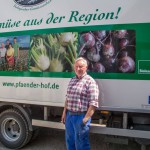Farm description
An important issue for Mr. Pfänder is the concept of a largely closed farm cycle especially with regard of his own farm having many intensive vegetable crops but no animal husbandry. A conscious decision for vegetarism of the whole family is an important foundation for running the farm. This forms the basis for the renunciation of farm animals as well as animal manure (except some minor amounts of horse dung from neighboring farms).
The since 1998 cattleless running Bioland farm Pfänderhof is located on 560 m above sea level and has, with an average annual temperature of 7,6⁰C a mean annual rainfall of 700-800 mm. On 48 ha loess clay soils and alluvial soils field vegetable crops (23 ha) and clover grass / grain (18 ha) are grown primarily. In addition, potatoes are grown (5 ha).There is little (2 ha) Grassland on the farm.
Climate friendly practices applied
- Improved on-farm nutrient management
Composting of on-farm residues
All on-farm residues are composted. Fresh piles consist of biomass of forage legumes, waste from vegetable processing, straw, soil from carrot washing. Due to the regular turning of the compost piles, CH4 emissions are reduced. Regular compost application contributes to C sequestration in soil. Furthermore, N2O emissions from mulching are avoided and N fixation of forage legumes is increased.
- Optimised crop rotations with legumes
Maintenance of existing grain legumes as well as summer and winter green manure lay with legume grasses). High percentage of green manure leys with forage legumes is maintained as well as grain legumes, both contributing to N fixation and C sequestration.
- Optimised tillage systems
Reduced tillage and undersown crops
Farm avoids ploughing prior to all arable crops (except vegetables). Furthermore, basic tillage operations are avoided for grass-clover due to undersown clover in spelt and oats. By employing these practices diesel consumption will be reduced along with humus accumulation in soil (C seq.).
- Agroforestry
Hedgerows and tree strips along agricultural fields
The farm installed hedgerows and tree strips, along with 0.9 ha forest which lead to C sequestration in above- and belowground biomass and in soil. Part of the woody biomass is used for composting; the energetic use of wood chips replaces fossil fuel (CO2 mitigation).
Location
Other farms
